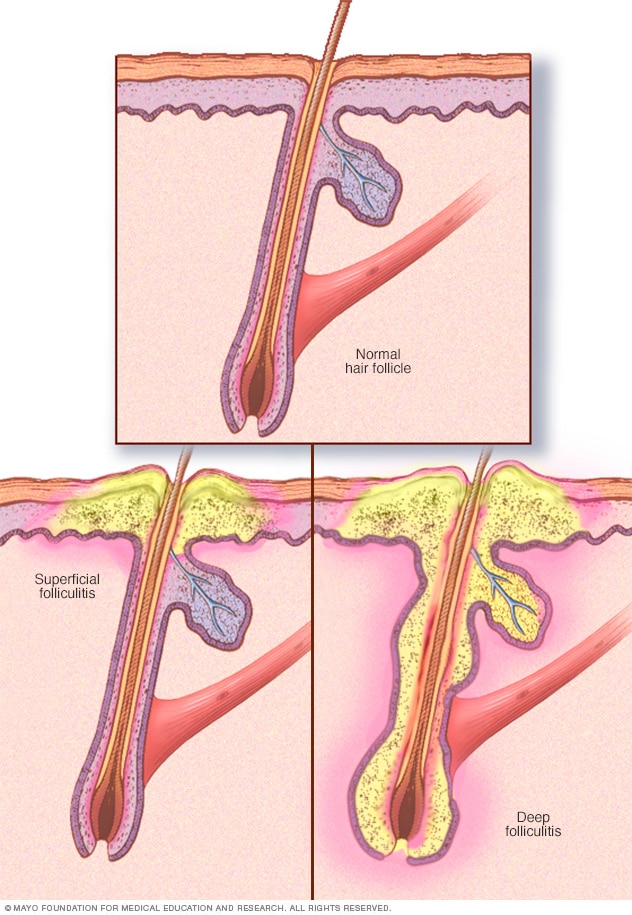
hair on your body grows from tiny sacs called follicles, which can become infected and inflamed over time. Folliculitis is an itchy, pus-filled bump caused by Staphylococcus bacteria that can enter damaged hair follicles through cuts or scrapes.
Causes
hair grows out of spots called follicles on your skin. When these become infected with an infection called folliculitis, this skin condition affects both men and women, but most commonly teenagers. It can occur anywhere on your body with hair and produces pus-filled bumps (pustules). Folliculitis, or folliculitis, is an infection of hair follicles surrounded by red to pink inflamed skin. While mild and moderate cases aren’t contagious, severe cases can spread into other parts of your body or worsen over time, potentially resulting in cellulitis – an infection of deeper tissues – or scarring. Staphylococcus bacteria and various types of fungi can cause folliculitis. Bacterial folliculitis can spread through skin-to-skin contact or sharing items like razors and towels. Fungal growth in hair follicles may lead to boils or carbuncles, which are pus-filled lesions. Additionally, thick moisturizers, medicines, or tight clothing can block follicles, leading to inflammation.
Symptoms
Folliculitis typically presents itself with red bumps resembling pimples on the skin (pustules), although it can occasionally manifest into painful boils known as carbuncles. They form when Staphylococcus aureus bacteria penetrate deep layers of the skin and cause an infection, often through frequent shaving or wearing tight clothing such as swimsuits. Other factors contributing to folliculitis include diabetes medication or medications such as lithium or cyclosporine, which have agents that lower immunity. Your doctor can identify folliculitis by inspecting your skin and gathering information about its history. They may order lab tests to determine which bacteria or fungus is causing the issue. Mild cases generally clear up on their own. At the same time, more severe infections might require antiseptic wash, antibiotic ointment, tablets, and hot compresses for treatment to avoid complications such as cellulitis, permanent scarring, or hair loss.
Treatment
Folliculitis usually resolves without scarring through essential self-care. More severe infections may require medical treatment from a licensed provider. Mild folliculitis usually resolves independently in several days, although it may recur and spread to other body areas. More severe forms can result in boils (furuncles) or carbuncles – large painful blisters that drain pus or turn dark in color before crusting over. Such cases of folliculitis may indicate a Streptococcal infection (streptococcal folliculitis). Staphylococcus aureus, a bacteria commonly found on the skin, may enter hair follicles through cuts or wounds and cause folliculitis. A skin sample may be sent for laboratory analysis to pinpoint which bacteria caused the infection. Your healthcare provider may also look for Malassezia folliculitis, an itchy red bump infection caused by yeast infections that can be treated using antifungal creams or medicine.
Prevention
Change your hygiene and self-care habits to help prevent folliculitis. Use clean towels and washcloths without sharing, avoid rough fabrics such as denim, shave in the direction your hair grows using an electric razor, wear breathable clothing during exercise to reduce friction between the skin and clothes, etc. Consult your healthcare provider if you suspect mild folliculitis due to bacteria. Your physician may also suggest antifungal creams or pills that fight infections caused by yeast. For cases of folliculitis that appear after bathing, your doctor may recommend taking two 30-minute bleach baths each week – this helps eliminate germs that cause infections while relieving redness, swelling, and itching. Hydrocortisone ointment may also help alleviate discomfort. Avoid popping, poking, or squeezing the bumps, as this could spread the infection further and result in scarring.

